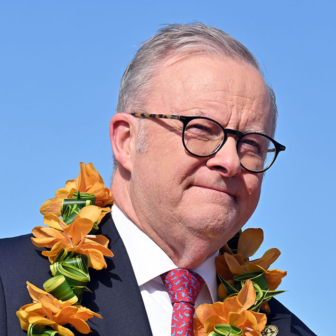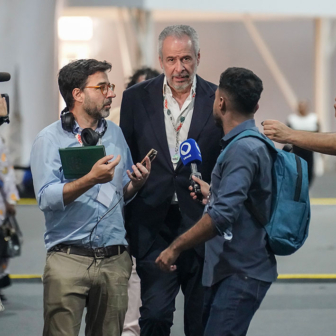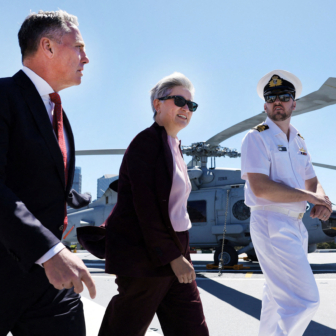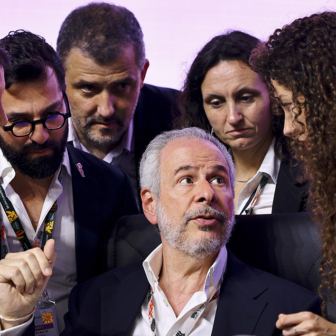It tells you something about the turmoil in the global economy caused by Donald Trump that the question on everyone’s lips as they arrived in Washington last week for the annual meetings of the International Monetary Fund and World Bank was: will the United States even show up?
US treasury secretary Scott Bessent may only have had to walk a few hundred metres from his office to meet his fellow finance ministers from around the world, but he hadn’t bothered to attend the last such gathering in February, so there was no guarantee he would attend this one either.
As it turned out, there was no need to worry. Bessent not only came, he also gave an important speech setting out the new administration’s approach to international economic governance. And it was not the scorched-earth approach many had feared.
The United States would not be withdrawing from the IMF and the World Bank, as some had believed it might. On the contrary, Bessent said, the Trump administration would seek to use these institutions to promote its America-first objectives. So the IMF should “call out” China for its “globally distortive policies and opaque currency practices” and it should stop focusing on “climate change, gender, and social issues.” The World Bank should not prioritise renewable energy but invest in nuclear power and gas as well — and it should stop lending to China.
Bessent’s speech had a near-universal reaction from those attending the Washington gatherings. “A huge sigh of relief,” one World Bank executive confided to me. These were the kinds of things you’d expect any normal Republican treasury secretary to say, I was told; they would mean some shifts but not a fundamental overturning of either institution’s policies. China was due to “graduate” from World Bank eligibility soon anyway; new nuclear plants are not economically viable, so the Bank’s approach to energy investment will not, in practice, need much revision. If Washington wants these institutions to talk less about climate change, that can be done. But climate risks are real economic risks, so investment to mitigate them will continue.
Bessent’s speech even held out a faint hope of progress. He asked the IMF to bring borrower countries and their creditors together to deal with “debt distress” — the crisis faced by the many lower-income countries more or less unable to pay their debts. His call echoed the words of the IMF itself, whose managing director Kristalina Georgieva used her own remarks at the Washington meetings to argue that some poorer countries need urgently to restructure their debts — that is, to get some kind of debt relief.
What Bessent didn’t say — but Georgieva did — is just how much worse the Trump administration’s trade policies have made these countries’ economic circumstances. In its annual World Economic Outlook, issued last week, the IMF downgraded its growth forecasts for the entire global economy and for almost every individual country. It blamed the extreme uncertainty caused by Trump’s on-again-off-again tariff announcements. And it pointedly observed that the countries that will be hardest hit by what it was not shy to call the US-induced “trade war,” alongside the global slowdown and the reductions in overseas aid accompanying it, will be the poorest and most vulnerable.
It’s worth recalling the extent of the tariff increases Trump imposed a month ago — increases that, though suspended, may yet be restored in July. Based on the administration’s trade deficit formula, almost universally derided by economists, they include tariffs of more than 40 per cent on some of the poorest countries in the world, such as Lesotho, Madagascar, Myanmar and Syria. Overall, says the UN’s trade and development agency UNCTAD, twenty-eight of the low-income countries that face higher tariffs each contribute less than 0.1 per cent to the US trade deficit.
While the tariffs will therefore make no material difference at all to the US balance of payments, they will devastate these countries’ economies. Lesotho has a large relative trade surplus with the United States because it has a per capita income of just over US$1000 a year, and so it imports very little. But over the last two decades — supported by US tariff exemptions — it has developed a vibrant textile industry exporting Levis and Wrangler jeans to the United States. Those exports now contribute more than 10 per cent of the country’s entire annual national income. With the United States imposing a tariff of 50 per cent, up to 30,000 people working in the jeans factories face losing their livelihoods, and the country its largest source of foreign revenue.
Madagascar is in a similar position. Like Lesotho it exports textiles to the United States, along with vanilla (for which it supplies four-fifths of the global market). One of the world’s most climate-vulnerable economies, recently hit by both droughts and hurricanes, it will be catastrophically hurt by a tariff of 47 per cent. Both Madagascar and Lesotho are also suffering the withdrawal of most of the US aid they previously received.
High levels of debt exacerbate many low-income countries’ plight. The IMF calculates that around half of the world’s poorest countries are in, or at high risk of, debt distress. Many borrowed lavishly in the period after the 2008 financial crash when interest rates were low, finding new lenders in the private sector and among Chinese banks alongside more familiar Western government creditors. But post-Covid inflation has pushed interest rates sharply higher. With most poorer countries not yet having fully recovered from the pandemic, and growth prospects looking grim again, the conditions are ripe for fiscal crises.
UNCTAD estimates that more than fifty developing-nation governments — nearly half of them in Africa — are now spending at least 10 per cent of their budgets on debt interest payments. More than three billion people live in countries that devote more funds to debt payments than to health or education.
New finance, meanwhile, has more or less dried up. Net flows have turned negative — that is, more money is flowing back to repay lenders than is coming in for investment. Many developing countries have only been saved from default by emergency IMF loans, with much of that money simply pouring back out again to repay private creditors from the rich countries.
And climate change is making the situation worse. Countries experiencing more frequent and more severe extreme weather events are having to spend more on disaster relief and recovery, and correspondingly less investing in education, job creation and growth. Meanwhile, rising temperatures and erratic rainfall are hitting agricultural production. As climate risks rise and growth prospects decline, borrowing becomes more expensive, reducing investment still further. It becomes a vicious circle.
But both the extent of the debt problem and the role played by its specific climate-related components are receiving increasing recognition, with a number of intense discussions away from the formal meetings in Washington last week.
At the same time as Georgieva was making her call for debt restructuring, World Bank chief economist Indermit Gill was repeating his own. The UN secretary-general’s adviser, former Egyptian investment minister Mahmoud Mohieldin, spoke at a number of meetings consulting on potential debt policy reform. Nobel Prize–winning economist Joseph Stiglitz and former Argentinian finance minister Martin Guzman chaired a meeting of the Vatican’s Jubilee Commission, an enquiry into sovereign debt set up by the late Pope, which is due to report next month. And an expert group established by the governments of Colombia, Kenya, France and Germany issued a major report linking debt to the environmental agenda.
The report, Healthy Debt on a Healthy Planet, sets out a program of reform to tackle what it describes as the “triple crisis” of indebtedness, climate change and nature loss being experienced by many low-income countries. It calls for the IMF and World Bank to incorporate climate and nature impacts more fully in their economic and financial analysis. It proposes new programs of debt relief for the most debt-distressed countries in return for higher investment in climate and nature resilience. And it argues for greater financing of that investment, including “debt for nature” and “debt for climate” swaps and leveraging private capital for climate mitigation and adaptation.
Launched at a packed meeting in the grand surroundings of the Colombian ambassador’s residence, the report offers a challenge not just to the IMF and World Bank but also to the array of finance ministers attending the Washington meetings. South Africa, which currently holds the presidency of the group of the world’s largest economies, the G20, has vowed to make debt relief a priority this year.
Before last week it was widely believed that neither China nor the United States would be willing to make concessions, so little progress would be made. But Scott Bessent’s speech may have changed the game. Attention is suddenly turning east. The developing countries are asking: will China be willing to come to the debt relief table? •




